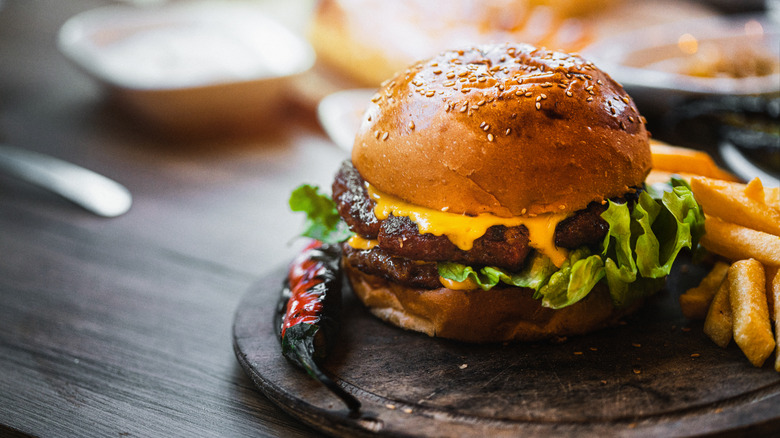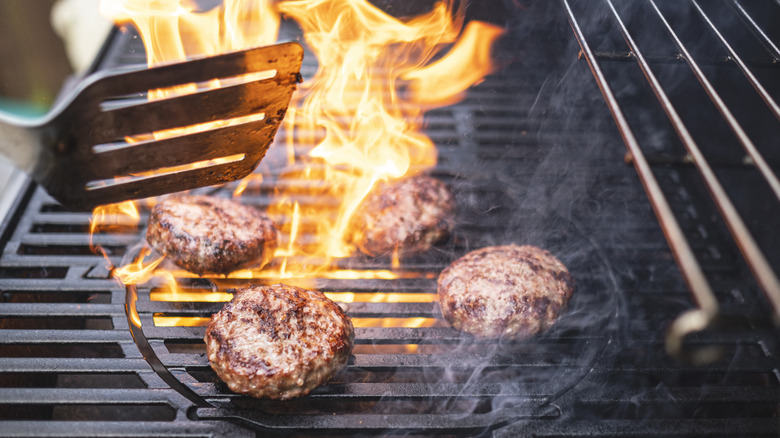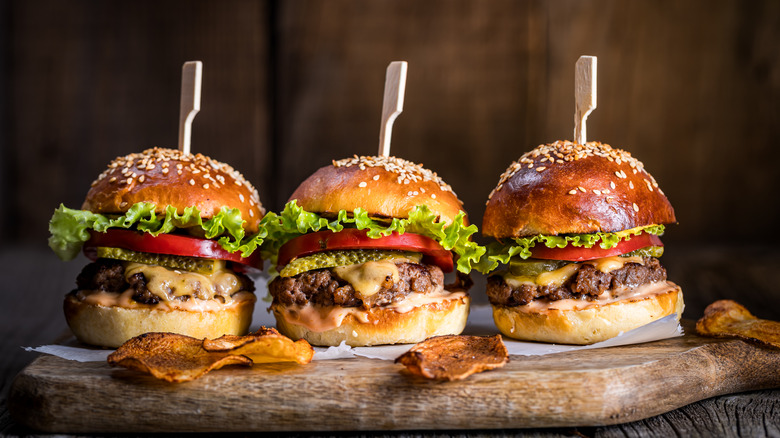There's A Better Way To Stop Your Burger From Shrinking In The Pan
It's hard to beat a classic burger. That savory meat patty is just the beginning when it comes to this handheld meal, as it's often enhanced with contrasting flavors (grilled onions and sweet bacon jam make for a slept-on burger pairing) and enjoyed on a pillow-soft bun that holds it all together. But if you have ever shaped the perfect-sized patties only to realize they shrink almost as soon as they hit the heat, you're not alone. Thankfully, there is an easy remedy: Make a large crater in the patties' center — about 2 inches wide and about 1 inch deep. Then, cook the flat side first. This will catch the juices and prevent the shrinkage — mostly.
No matter what type of meat you cook, it will shrink when it hits heat. To prevent shrinkage, you'll want to cook your burger patties at a lower temperature in addition to the crater trick. High temperatures remove more moisture and fat quickly, which is what leads to that unwanted shrinkage. Even if you want those grill marks, it's worth it to lower the heat to get a juicier, more sizable patty instead.
Use the crater trick to stop your burger from shrinking
When the meat starts cooking, the outer edges lose moisture first. The juices make their way to the center, which causes the patty to puff up and creates unwanted shrinking. By adding that large dent, you're counteracting the puffing and helping hold those juices, and the finished product is a burger patty with little shrinkage. The indent gives the center of the patty room to puff up a little bit and essentially helps you wind up with a perfectly flat burger.
As meat cooks, moisture evaporates out, effectively condensing the meat because it's losing its water weight. With that said, while the indent helps reduce shrinkage and lets the burger maintain its shape, it won't absolutely prevent it. Another easy trick to get the perfect-sized burger is to form the raw meat patty a bit larger than you need it to be (so, a slightly longer diameter than the bun). This easy step builds in room for that shrinkage, leaving you with a cooked patty that fits perfectly on the bun.
The dos and don'ts of preventing burger shrinkage
The crater and oversized patties are two easy "dos" to ensure your burger is the perfect size and shape, but you can also adjust the cooking temperature, too. High temperatures result in more rapid moisture loss, so for those perfect char marks, you can cook the burger at 450 degrees Fahrenheit, but to retain more moisture and build the juiciest burger possible, you're better off cooking it at 350 degrees Fahrenheit. This is the low end of the range burgers need to caramelize on the outside without getting too dry on the inside.
Do not press down on the meat as it cooks in order to stretch it and shape it. (The exception here is when making a smash burger, which cooks in minutes and is pressed the moment it hits the heat.) While pressing might stretch the burger out, it also removes liquid from within the burger, which reduces its moisture and fat — both of which give it flavor. And finally, don't flip the burger patty more than once. With each flip, the burger loses a little more juice, removing moisture and resulting in a smaller, dryer patty.


